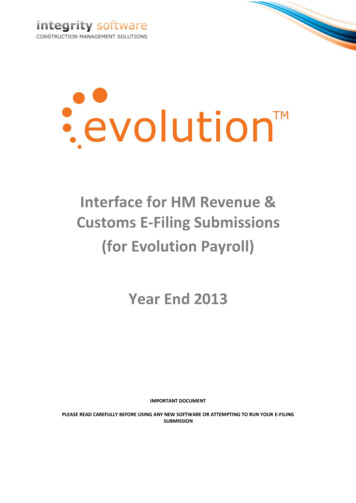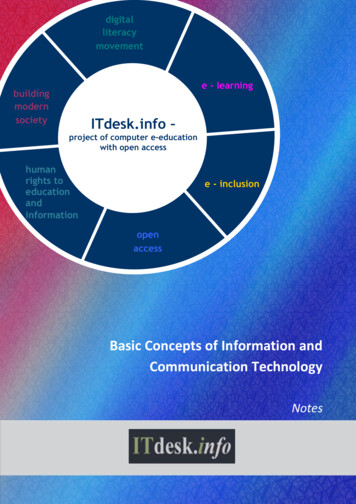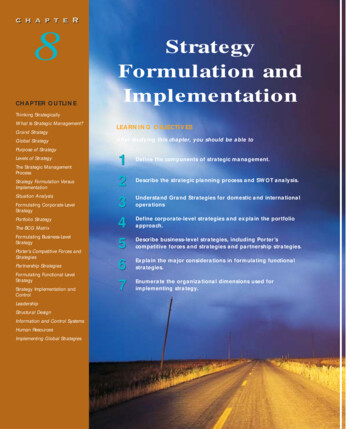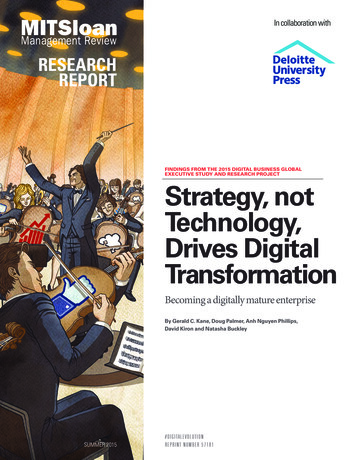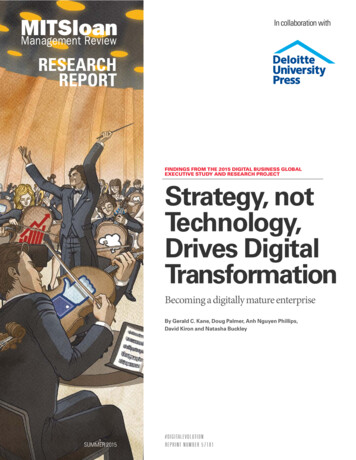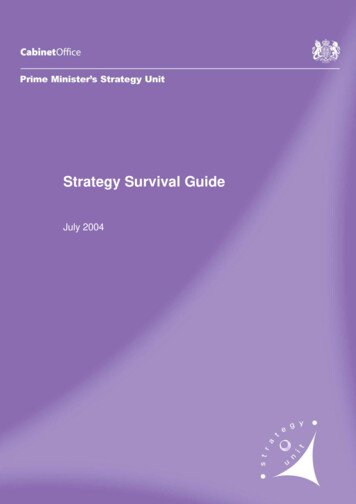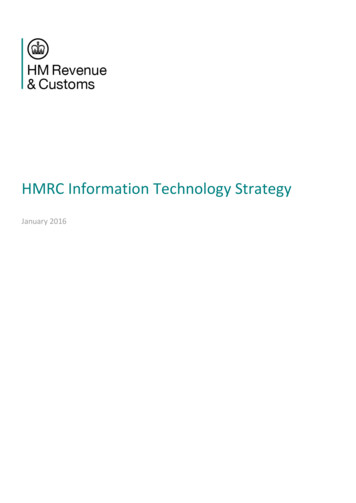
Transcription
HMRC Information Technology StrategyJanuary 2016
Contents Executive summary Document purpose HMRC strategic context Making tax digital IT contribution to HMRC transformation Supporting directorate business plans IT principles and standards IT accessibility IT delivery and sourcing IT governance IT people and skills Risks IT architecture platforms Annex A – IT principles full list2
Executive summaryThis IT Strategy outlines the technology approach that will enable HMRC’s long term vision and ensureour digital services and enterprise systems have a modern technological footing. We will ensure the nextgeneration of services are first-rate through the delivery of a world-class architecture, driven by realbusiness transformation.Our future technology will support and adapt to changing customer and business needs. We will: re-engineer and rationalise the applications into standard reusable services, built around customers‘subscribing’ to HMRC productsstandardise and rationalise business processes to support online, real time customer transactionsimplement industry standard financial accounting processes that support line of sight fromindividual transaction to HMRC’s core accountsdevelop world class data analytics capabilities to support customer service, reduce cost and increaseyieldexploit commodity software products that deliver best value for money and deploy, based on thebusiness case, open source alternatives to proprietary productsdecommission outdated and inflexible legacy systems, removing the risk to our mission criticalservices and reliance on diminishing niche skills to support and develop themunderstand the cost drivers and, with business agreement, make balanced decisions on cost,speed, functionality, and risk, including impact of failure.So that: we continue to run and maintain a daily IT service for our customers HMRC becomes a truly digital organisation HMRC can find secure ways to achieve its goals that balance risk management with businessobjectives we can transform the performance of the Department through exploitation of cloud infrastructureand technical services we run public services in a cost-effective way we deliver cost savings in line with the spending review.In turn, the Chief Digital & Information Officer Group (CDIO) – HMRC’s IT and digital function - willsupport the Department in maximising revenue flows to the Treasury by: continuing to reduce IT downtime for internal and external servicesmaintaining daily IT service standardsdelivering IT projects on-time and to quality standards.3
Document purposeThis document sets out the HMRC IT Strategy for the Spending Review Period. It is a description of howHMRC’s Chief Digital & Information Officer (CDIO) will deliver the required IT capabilities to enable andsupport the delivery of the Departmental Business Strategy.This document will be made available externally as part of HMRC’s obligation and commitment totransparency in government. It will give the public, suppliers and other interested parties insight into howHMRC will address Information Technology issues and its choice of solutions now and in the near future.This document will be reviewed annually to ensure it remains valid and relevant.HMRC strategic contextWe are the UK's tax, payments and customs authority. We collect taxes and duties from 45 millionindividuals and 5.2 million businesses, support trade and growth through customs and pay tax credits to4.6 million household and Child Benefit to 7.5 million families. We are also one of the country’s largestemployers.Our work contributes to the country’s economic and social wellbeing and supports growth. The UnitedKingdom is the world’s seventh largest economy and the second largest in the European Union and weplay our part by making it as easy as possible for industry and business to trade, helping businesses toaccess reliefs that encourage investment, employment and growth.We also work with a number of other government departments to help deliver their objectives; forexample, collecting student loans.Our core role is to administer the tax system efficiently and ensure that the right people pay the rightamount of tax at the right time. We believe that by designing our products, processes and servicesaround our customer needs we will maximise their compliance with the least cost to us while providingthe best service for them. We have always focused on three core objectives: maximise complianceincrease efficiencyimprove customer experience.The vast majority of our customers willingly comply with their tax obligations. We will seek the highestpossible level of voluntary compliance and maintain our position as a trusted and professional taxauthority by: being seen to act fairly and treating customers with the respect they are duemaking it as simple and low-cost as possible for those who try to comply and offeringcomprehensive support where most neededminimising the opportunities for error, evasion and avoidanceencouraging people to take care with their tax affairs/meet their obligations and providingcompliant customers with certainty when they do sodetecting and tackling those who try to evade taxpreventing and disrupting organised criminal attacks on the Exchequer.4
We also include and involve our people in how we meet these objectives and ensure that we invest intheir skills, capability and the experience they have of working in HMRC.Making tax digitalThe government’s vision for making tax digital is about much more than simply adding digital tools to thecurrent system; it’s about transforming the UK tax system into something that feels completely different.Transforming our tax system has four foundations. Tax SimplifiedTaxpayers should not have to give HMRC information that is already has or should be able to getfrom elsewhere – for instance, from employers, banks, building societies and other governmentdepartments. Taxpayers will see the information that HMRC holds through their digital taxaccounts, be able to check at any time that their details are complete and correct. We will use thisinformation to tailor the service we provide, according to each taxpayer’s individualcircumstances. Tax in One PlaceTaxpayers will be able to see their complete financial picture in their digital account, just like theydo in their online banking. They will be able to set an over-payment of one tax against the underpayment of another; it will feel like paying a single tax. Making tax digital for businessBusinesses should not have to wait until the end of the tax year or even longer before knowinghow much tax they should pay. HMRC will collect and process information affecting tax in as closeto real time as possible, to stop tax due or repayments owed from building up. Making tax digital for individual taxpayersIndividual taxpayers will interact with HMRC digitally and at any time to suit them. Every individualand small business will have access to a digital tax account. These accounts will present individualtaxpayers with a personalised picture of their tax affairs, along with prompts, advice and supportthrough webchat and secure messaging.5
IT contribution to HMRC transformationHMRC has a very complex IT landscape with nearly 600 different IT applications. Some of these were builtat a time when data was entered into mainframe computers using punched cards. Our core tax systemswere designed to manage products not customers. The 2005 merger of Inland Revenue with Customs &Excise resulted in duplicate systems, especially around financial accounting, that still persist today.Modern day business computing seeks to integrate line-of-business financial transactions with back officeorganisation financial systems and the associated operational reporting. We face an ageing ICT estatewhere data fragmentation allied to manual processing interventions will struggle or fail to support thedemands of the digital age.We have achieved cost reductions through major contract re-negotiation, however the IT estate is stillcostly to manage due to a dangerous dependency on legacy mainframe operating systems and is difficultto change and keep pace with the increased and evolving IT demand.The key to transforming our IT estate is re-engineering what we have so that the majority of our ITapplications can run on virtualised infrastructure environments with as much as possible hosted oncommodity cloud services. As we modify our approach to application, database and infrastructureengineering, we will move with the market as it develops, as opposed to lagging behind it.HMRC TransformationTechnology is enabling a much wider programme of change, with the HMRC Spending Reviewcommitments at its heart. Our individual transformation programmes are supported by joint businessand IT pillars to ensure alignment and a clear means to achieve the Department’s business objectives. Thefoundation elements are led by technology; infrastructure (network, desktop), the contract replacement(operating model, commercial & supplier) and people capabilities (culture, ways of working, careerpathways) are fundamental to everything we want to achieve.6
This transformation is built around a converged business model and there are some criticalinterdependent IT enablers we have identified.Converged Business ModelThere will be three core tax administration platforms. Individuals Tax management platform (ITMP)Will be based on the National Insurance and PAYE Service (NPS) and will the home for personaltaxes. Enterprise Tax Management Platform (ETMP)Will provide a single, cohesive environment where core tax management and financial accountingprocesses can be effectively and efficiently hosted. Based on SAP it is the home of business taxesand duties, as well as our corporate HR and finance systems. Customs Declaration Services (CDS)Replacement for Customs Handling of Import and Export Freight (CHIEF) will rationalise andtransform the asset base into a modernised, simplified, streamlined and more integrated suite ofsystems that are easier and more cost effective to maintain, and which also enable HMRC tocomply with EU legal mandates.7
And five cross-cutting platforms: Case managementA single case management system for compliance and exception processing, enabling faster,cheaper workflow with common service use for escalations and exceptions. Digitisation of whitemail through our new Digital Mail Service, enabling scanned mail to be retained on the singlecustomer record. Data and risk analyticsNew generation of upstream risk analytics tools spearheaded by an Enterprise Data Hub (EDH)that intrinsically links digital services and data analytics; consolidating our existing datawarehouses into a single instance which will be updated in real time by new transactions receivedfrom customers, enterprise systems and external sources. We will have improved data quality todeliver a ‘Golden Customer Record’; removing duplication of information and rationalising existingdata sets further to reduce storage costs; with improved confidence and validation in our entiredata lifecycle by using identity assurance, date, time, and source verification. Debt managementRemoving costly legacy applications and migrating the functionality to developed shared servicesfor debt management. FinanceImproving the efficiency, timeliness, and accuracy of financial reporting through the use of a singlefinancial reporting platform. HRUpdating HR to improve user experience, providing better strategic workforce planning andanalytics.Our Multi-Channel Digital Tax Platform (MDTP) is about designing services around customer segmentswith different requirements that need different kinds of help, and which everyone will access via one ofthe digital tax accounts or via an API. It will be centred on providing a secure, reliable, flexible andscalable platform (100% API) for HMRC’s new or enhanced digital services, enabling them to bedeveloped quickly and easily, based on customer needs.8
MDTP Customer SegmentsWe will also need a Contact Management (CM) component that not only meets and improves existing CMfunctionality in the telephony channel, but is also extensible to manage contact through a range of otherchannels (webchat, SMS, secure email). We will support our workforce dealing with queries by havingimproved call handling and queue management capabilities with a holistic, truly ‘multi-channel view’ ofcustomer contact across all available channels; increasing customer and end user satisfaction.Virtualisation technology brokered from multiple vendors, moving to a disaster tolerant environment withless focus on disaster recovery will help HMRC transform our data centre hosting platforms fromtraditionally dedicated physical resources to virtual cloud based services.Cloud Brokering Model9
Cloud will offer: on demand service – self-service delivering capacity quickly from a number of Cloud providersbroad network access – widely accessible, from a variety of devices / platformsresource pooling – shared capacity allocated according to demandrapid elasticity – scale rapidly up as well as downmeasured service – transparent, pay-per-use.This will deliver: better value for moneygreater flexibilityfaster provisioningimproved options for resiliencereduced running costs across our IT estate.We will protect customer information from cyber criminals, improving customer trust, confidence anduse of digital services. We will continue to enhance the range of activities that the HMRC Cyber SecurityCommand Centre will undertake to provide assurance and real time event and incident managementacross our online services, systems and computer networks, to guard against the risk of attack, malware,and insider threats.In addition to the core IT elements we will: implement workforce transformation to equip our people with the right tools to increase theirproductivity and encourage collaborationput in place a flexible IT sourcing strategy to acquire the capabilities we need and ensure that weget best value for our investmentshave an agile IT change delivery capability to enable the collaborative design and delivery of bothbespoke and packaged solutions in an environment of multiple design, and multiple deliverylocations and partners.Supporting directorate business plansThe aforementioned IT contribution is playing a significant role in HMRC’s transformation and how thedifferent directorates will operate in the future, however CDIO has also has an important part to play indesigning and delivering other elements of HMRC’s Business Strategy and directorate business plans andwe are supporting these areas in different ways.Enforcement & Compliance (E&C) – we are: investing in data and intelligence systems to make more use of the customer information wecollect; by joining up and analysing our data, HMRC will deepen our understanding and be able totailor compliance activity accordinglysignificantly improving our evasion targeting capability and maximising our civil and criminalintervention opportunities through an improved Connect 2 system, and the introduction of 2Factor Authentication and Verify10
moving analytics, planning and performance reporting functionality to the EDH, enabling us toprogress our data-driven approach, in line with HMRC’s Promote, Prevent, Respond strategy forDebt Management & Bankingimplementing predictive analytics functionality for early debt management interventionsintroducing electronic presentation of evidence for enforcement and a Digital Evidence Capabilityto handle litigation cases more effectivelyImproving our Criminal Case Management SystemBenefits & Credits (B&C) – we are: launching an iteration of online Child Benefit platform introducing online Tax-Free Childcare platform to support parents for their childcare costs exploiting our real time information to identify potential impacts to entitlements and, withavailable prompts (such as SMS), inviting responses from customers to avoid overpayments enhancing pre-payment checks to prevent error and fraud in the systems enhancing the Tax Credits digital service allowing more customers to ‘self-serve’.Personal Tax (PT) – we are: preventing non-compliance through initiatives such as pre population of returns reducing the number of work management items through automating clearance making it easier for international customers and professional agents to deal with HMRC by usingshared workspace and secure messaging replacing interim iForms with digital services so customers can see changes immediately.Business Tax (BT) – we are: reducing call volumes by providing guidance and advice upfront through webinar capabilities providing customer relationship managers with data analytics to identify risks in real time working with third party software developers to increase the potential of software products thatwill improve the accuracy of business record keeping contributing to UK growth agenda through customs transformation operating as One Governmentat the Border transforming the Customs Declarations Service; bringing in Union Custom Code and enabling tradeto operate more effectively and legally.People and finance (corporate functions) – we are: improving Online HR, making it more intuitive and enabling staff to customise it to meet theirneeds when self-serving creating a single digital portal through which managers can access all management-relatedlearning opportunities as part of the Management Academy creating new working environments, with modern facilities and equipment:- deploying a flexible device strategy across the Department- delivering Wi-Fi to HMRC buildings – enabling everyone to access their applications easilyand at any time- encouraging greater networking and cross-HMRC working, by making full use ofcollaboration tools.11
IT principles and standardsThe provision of principles is an aid to solution design: the principles, their relative priority, rationale andimplications will help to refine IT solutions and to decide between alternatives. They help to make implicitconditions explicit and set the boundaries and context within which a solution should sit as distinct fromspecific requirements that will also be established.Our IT principles are derived from and consistent with: the strategic vision for HMRCthe benefits the Department must deliverdocumentation describing existing models, technology, processes that are utilised by HMRCany internal and/or external standards/regulations that applyinnovation and research studieswider government principles and standards.These principles are consistent with departmental guidance and reflect government, HMRC strategic, andIT plans allowing for HMRC’s IT to abide with legislation, policies, and regulations. These will not precludebusiness process improvements that lead to changes in legislation, policies and regulations. Ourarchitecture principles are flexible, consistent and simple, enabling HMRC to achieve its goals bysupporting architectural decision making. In addition to the strategic objectives, our principles havetechnology ambition at the core, this includes: greater IT functional excellencereducing IT complexityreduce carbon footprint.Given HMRC’s scale and ambition, our principles are grouped by the architecture domains and aremapped to the strategic drivers of both the business and technology to ensure they give direction and addvalue.Architecture Domains12
The full list of IT principles is in Annex A.In addition to adhering to the Government Digital Strategy all HMRC digital services will align to theGovernment Digital Service standard1.All HMRC IT services will commit to the actions set out in the Government Digital Strategy2 whichsupports the Civil Service Reform plan to develop services that allow straightforward access toinformation and services in times and in ways that are convenient to the users rather than the providers,and are more efficient and cost-effective to develop and run.IT accessibilityIT Accessibility has to be looked at from two perspectives: standards for developing systems and supportfor users of customer and staff-facing systems. We will design, build and procure our IT systems so thatthey can be used by any user – disabled or not – and we will provide all appropriate support to our staffand customers to allow them to do so. Our aim is to be an exemplar in this field, and not merely deliverthe legal minimum.In conjunction with the HMRC Disability Plan, we will address IT accessibility issues by: aiming to build our staff and customer-facing systems to international standards, principally theWorld Web Consortium’s Web Content Accessibility Guidelines (W3C WCAG) AA standard, inaddition to the standards for all aspects of customer facing systems development are set centrallyby the Cabinet Officeapplying W3C3 standards in our IT procurement exercisesembedding accessibility principles into the software development life-cycle and associatedgovernance processesproviding dedicated support and testing on all supplier/in-house built systems and associatedupgrades; ensuring accessibility champions are embedded into the developer communityproducing upon request departmental documents in a variety of formats including large print,braille and MP3striving for continuous improvement through monthly feedback from customers on theaccessibility of our systems, gathered by our digital services teammaintaining a catalogue of tested and approved specialist products and assistive technology thatcan be deployed quickly to our staffworking closely with the Disability Network, providing generic software training for our assistivetechnology to be used with corporate systems.IT delivery and sourcingThe Aspire contract (a major outsourcing contract to primarily Capgemini and Fujitsu) will end in 2017.We have already started to plan and execute the transition away from this replacing it with a model withmore in house skills and a wider range of suppliers.1Government Service Design Guidelines - ltGovernment Digital Strategy ent-digital-strategy/government-digital-strategy3 World Wide Web Consortium (W3C) - http://www.w3.org/213
We are maximising further opportunities for cost savings by aligning our architecture domains anddelivery methodology with the supplier model and new service delivery model and supporting increasedleverage of our internal IT function.We will support the government-wide ambition to re-invigorate the small and medium enterprise (SME)community by utilising competition to deliver new solutions and services, within the constraints of theexisting contract, to increase our procurement spend with SMEs.We will continue to utilise government framework contracts including G-Cloud and Digital Marketplace,whilst making use of the innovative services provided by SMEs through existing and emerginggovernment procurement frameworks.We have moved away from the traditional biannual waterfall delivery model, to a monthly releaseprocess that combines both agile and waterfall delivery methodologies, which requires significantprocess, skills, organisation, and behavioural change.To support the new delivery methodology we have created delivery centres. These will bring together allthe skills required to develop and operate key services. They will be staffed by a combination of HMRCstaff and partners, and led by HMRC. The final mix of HMRC and partner staff will evolve as we gain moreexperience. This will enable the collaborative design and delivery of both bespoke and packagedsolutions in an environment of multiple design locations, multiple delivery locations and partners.All IT projects will operate in an agile, iterative manner, unless this is not appropriate. As a result, weanticipate faster, slicker, quicker IT solutions, greater focus on delivery and customer service whilstsupporting the government’s SME growth agenda.IT governanceWe have a mature approach to change governance and a skilled in-house IT team. The CDIO isaccountable for all IT developments, with all spend subject to HMRC and Cabinet Office spendingcontrols. Where decisions require investment greater than the departments delegated authority, we willseek early engagement with the Cabinet Office / Government Digital Service to discuss the initiatives,although the final decisions may rest with ministers.CDIO Group operates an Architecture Review Board (ARB) to ensure that all new and modified platformsare appropriately designed and conform to agreed principles and standards. Any deviation from thesestandards must be approved by the CDIO. There is also a Technical Design Authority (TDA) to approvenew technology being integrated to the IT estate, ratify product selection (software or hardware) andchanges in the direction of architecture blueprints.When deploying services into the live environment, CDIO work closely with all stakeholders to ensurethey are satisfied the new services or modifications are fit for purpose, the business is ready for changeand any potential risks or operational impact is acceptable.IT people and skillsIn line with HMRC’s wider transformation as part of Building our Future (HMRC’s national conversationabout the Department’s future), CDIO Group will be a smaller, more efficient workforce, with a smaller14
footprint located across a model of regional centres (and a smaller number of specialist sites). Throughthis investment in the future location strategy of HMRC’s workforce, we will work together to transformthe way we work in CDIO, building the digital, data, leadership and other skills we need in order to enablenew ways of working in the workplaces of the future.CDIO Group will identify the future skills, behaviours and culture that will create an environment thatinvolves, motivates and develops our people, strengthens leadership, enables them to be innovative andcreative whilst improving professionalism;CDIO Group will have leaders at all levels who show passion and commitment, and who understand, ownand promote what we want to achieve. Our leaders and managers will be at the forefront of helping ustransform HMRC.By aligning our people to the changing business needs, we can monitor and track our workforcedemographics to ensure that issues are addressed in a timely manner, developing scenario basedworkforce plans to fully inform the requirements for recruitment, moves and redeployments.We will give our people the opportunity to learn, develop and progress in their careers, so we will investin the skills and knowledge that are critical to the future delivery of our business. We will analyse any skillsgaps that arise, plan development to plug these whilst supporting individuals to develop their careersusing the CDIO career pathway.We will create a more engaged workforce by communicating with our people more openly and honestly;changing the way it feels to work within CDIO Group, allowing people to feel empowered to takedecisions that they are best placed to make.To ensure we remain a high-performing IT organisation, we will set clear objectives around what weexpect from our people. CDIO Group will continue to: commit to meaningful actions to tackle those factors within our control which drive engagementutilising the Skills for the Information Age (SFIA) framework to measure our internal skills andidentify gaps and areas for developmentpromote use of cross government development programmes (e.g. positive action pathways)work with universities to pilot IT industrial business placements whilst also working with TechPartnership UK to trial the new IT honours degree apprenticeshipswork with Civil Service Digital & Technology graduate schemes to nurture the next generation oftechnology leadersembed an ethos of volunteering in the local community with our people, sharing our skills andbuilding the digital skills of our local communities.RisksCDIO Group is under continual pressure to deliver cost savings year on year, at the same time as demandfor IT services and digital transformation continues to rise. Whilst savings must be realised throughexisting initiatives, including supplier-contract novation (where appropriate and compatible with publiccontract procurement principles) and the decommissioning of unnecessary services, new opportunities torealise savings through digital transformation must also be continuously identified and capitalised. Thisputs considerable risk into delivering the budget in such a dynamic environment.15
This move towards a digital service increases the risk to all of HMRC, government and UK Plc. Theambition to transform the IT delivery model, at the same time as develop services and the infrastructurerequired to deliver new digital services is a challenge and comes with significant levels of risk.There is a large risk that CDIO Group in particular does not have and will not be able to resource sufficientstaff with the necessary skills to deliver the IT Strategy. There are critical and ongoing dependencies onimprovements to organisational agility, technical exploitation, strong leadership, professional skills andstaff motivation in order to achieve the ambitions.Operational risks are managed by the relevant departmental, project and programme boards, and CDIOGroup will work to mitigate these risks on behalf of the Department.IT architectureTo aid the re-engineering and rationalisation of the IT, we have broken the conceptual architecture intomajor IT platforms and developed detailed ‘IT Architecture Blueprints’ for each of them, focussing onreusable services that can be used holistically across HMRC.Blueprints mapped to Architecture DomainsThis section of the strategy summarises each of these domains; the detailed blueprints are available andcan be shared on request.16
DigitalOur focus on this platform will include: archite
This IT Strategy outlines the technology approach that will enable HMR's long term vision and ensure our digital services and enterprise systems have a modern technological footing. We will ensure the next generation of services are first-rate through the delivery of a world-class architecture, driven by real business transformation.

